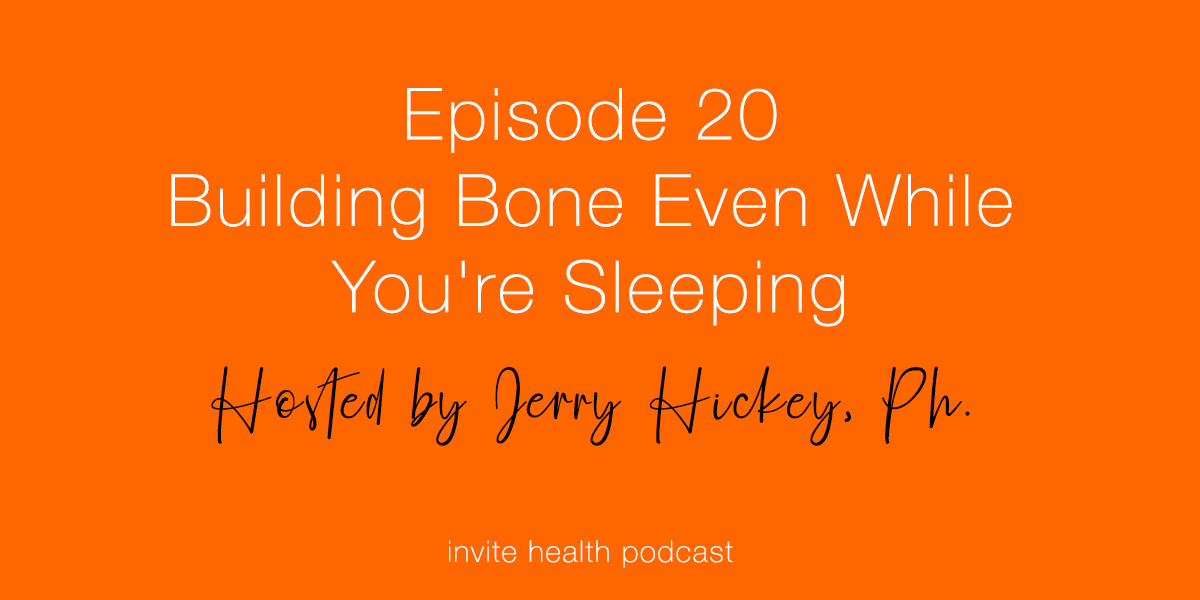Building Bone Even While You’re Sleeping – Invite Health Podcast, Episode 20

Invite Health Podcast, Episode hosted by Jerry Hickey. Ph
Subscribe Today!
Bone is complex and it has many functions. Besides holding us upright and allowing us to move, bones protect our internal organs and tissues and store minerals to adjust the pH of the blood.
Many cells are created inside of bone; red blood cells that carry oxygen, white blood cells for immunity, and platelets for blood clotting are all formed inside bone. There is even evidence that bone helps control metabolism to help prevent conditions, such as diabetes. Bones are complex and bone health is more than just calcium and vitamin D 9although these two nutrients are helpful).
Throughout life, until we reach an older age, there is a balance between removing old worn out bone and replacing it with newly formed tough bone; this balance of building and removal fails with age and we have a net loss of bone. Indeed, 20% of older men and 50% of older women will suffer from an osteoporotic fracture, meaning a fracture due to bone loss in their 50s or beyond.
These fractures are painful, can be very dangerous, are costly to treat ($40,000 for a hip fracture) and require many trips to the doctors office and physical therapy to treat.
Interestingly, you really can build bone, even when you are in your 80’s and this happens both day and night. Listen on… and learn some of the less well known secrets to building bone at any age.
What exactly is bone?
Bone is a rigid organ – it makes our skeleton. It protects organs inside our body such as our lungs and heart, it produces red and white blood cells and also platelets.
Bone acts as a store house for minerals and releases them when needed, such as during blood electrolyte loss (after sweaty exercise) or to keep blood slightly alkaline so you don’t go into a coma if it becomes acidic.
Bone provides structure and support for the body, and enables mobility. They come in a variety of shapes and sizes and have a complex internal and external structure. They are lightweight yet strong and hard, and serve multiple functions. Cortical bone is the hard outer layer of bone. Cancellous bone, also called trabecular bone, is the inner, porous, spongy bone.
Some facts about bone;
Your entire skeleton weighs about ten pounds and you remove and replace about 10% of it each year, so there is a balance of removal and rebuilding to maintain strong, fracture-resistant bone.
This changes as you get older; When you are young and strong a protein in your body called RANKL triggers cells called osteoclasts to remove old bone. There is a balance with a second protein called osteoprotegrin, which triggers a bone building cell called an osteoblast to get to work and build bone. With age this balance fails us.
Clinical Studies on Bone Health and Specific Nutrients
Interestingly, Green Tea stimulates Osteoprotegerin and inhibits RANKL, which slows down the breakdown of your bones.
- Fewer fractures and stronger bone, if taken before exercise
- Works best if consumed before exercise (bone, muscle, fat burning)
You truly can build bone at night. Melatonin helps set you up for sleep. MIT (Massachusetts Institute of Technology) shows that Melatonin does help you get to sleep quicker, enable you to sleep longer and deeper. But Melatonin levels can drop with age, which can impact your bone health. Your circadian rhythm has to do with bone building and removal.
A research institution in Denmark (Aarhus University Hospital) published a study in the Journal of Penial Research, reporting with increasing age, melatonin levels decline which can lead to an imbalance in bone remodeling. They took 81 older, menopausal women with osteopenia (at a greater risk of breaking bone), and gave them either a placebo, 1mg of melatoninm, or 3mg of melatonin for an entire year at night. Researchers studied the participant bones throughout the study and found that, when compared to placebo, in the fermeral neck with 1mg of melatonin, it improved bone mineral density in the hip bone by .5%. In participants who took 3mg of melatonin, it reversed the loss of bone by 2.3%. And in the higher potency, by 3.6%.
Exercise is obviously very beneficial for specific muscles, but it also supports bone health. That’s because the bone building hormones released during exercise impacts your entire skeleton.
Key Topics:
- Alkalinity and pH levels
- Fish Oils for the structure of bones
- Collagen, a bone-specific protein that makes up 36% of your bone (University of Illinois College of Medicine in Chicago, Case Western Reserve in Cleveland and University of Florida in Gainsville)
- Strontium supports new, wider bones
Just to review, many things are needed for bone health, not just drugs, calcium and vitamin D, and if you pay attention to at least some of these they can further truly help reduce your risk of a costly, painful, dangerous bone fracture.
In a future episode, I will discuss the benefits of BioCurcumin for memory and brain health and also for the aging brain.
Thank you for tuning in to the Invite Health Podcast. You can find all of our episodes for free wherever you listen to podcasts or by visiting www.invitehealth.com/podcast. Make sure you subscribe and leave us a review! Follow us on Facebook, Twitter and Instagram at Invite Health today. We’ll see you next time on another episode of the Invite Health Podcast.
